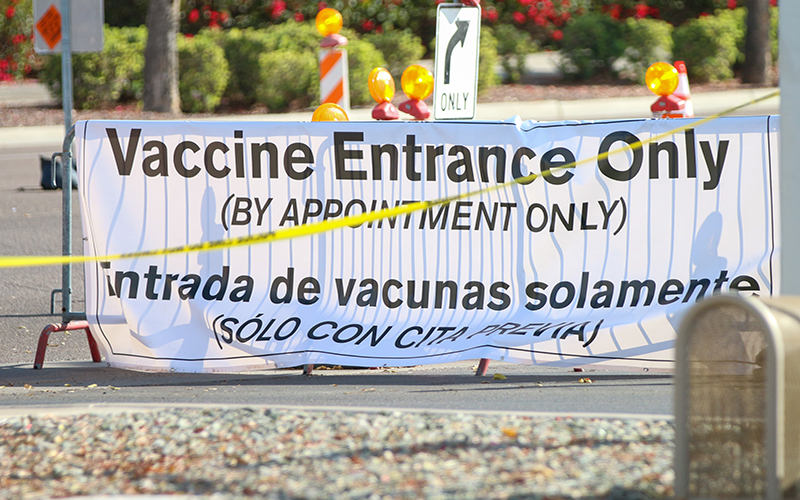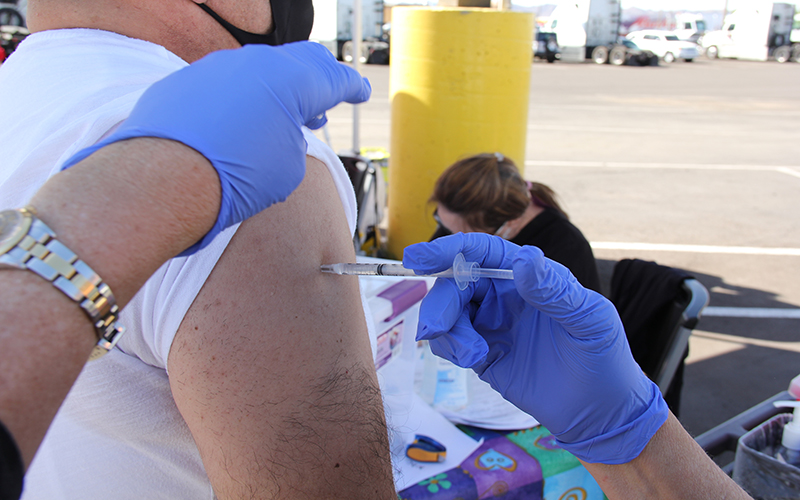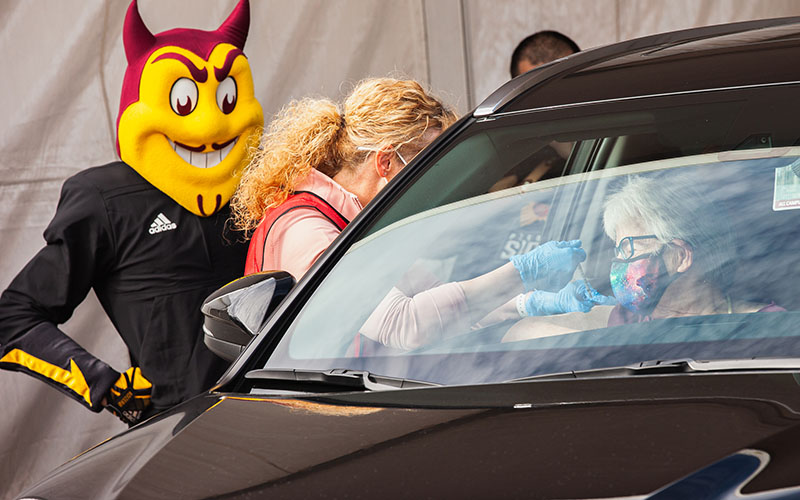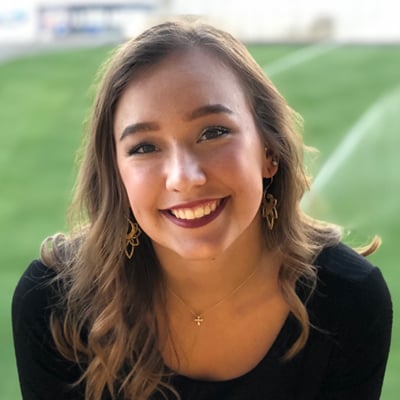
A sign directs cars at the vaccination site at State Farm Stadium in Glendale. Data shows some predominantly Hispanic and impoverished neighborhoods have far lower vaccination rates than those that are mostly white and well-off. (Photo by Marlee Smith/Cronkite News)

An essential worker gets vaccinated at a special event Bashas’ food stores set up for its workers in Chandler. Overall, 30% of eligible Arizonans have received at least one shot, and about 19% are fully vaccinated, but rates for people of color are lagging. (Photo by Travis Robertson/Cronkite News)
PHOENIX – A March report by the Centers for Disease Control and Prevention praised only two states for their efforts in getting vaccines to vulnerable communities. One of them was Arizona.
But while the federal report shows strong outreach at the broader county level, ZIP code data from the state health department reveals disparities with the vaccination rates in several neighborhoods where residents are predominantly people of color and more impoverished.
In Maricopa County – the most populous of Arizona’s 15 counties and home to most of the state’s COVID-19 cases and deaths – areas that stand out include the west Phoenix ZIP codes of 85009, 85035 and 85301, where data shows 15%, 16% and 17%, respectively, of residents 18 or older have received at least one shot.
Each of those ZIP codes is home to more than 50,000 people – and all are majority Hispanic with at least a quarter of residents living in poverty, according to census data.
In comparison, some of Arizona’s highest vaccination rates are in places such as Sun City West’s 85375 ZIP code, where 75% of adults have gotten at least one shot, and Pima County’s Green Valley – ZIP code 85614 – where the number is 73%. Residents in those neighborhoods are mostly older and white, and few live below the poverty line.
Overall, 30% of all eligible Arizonans have received at least one shot as of April 1, and about 19% are fully vaccinated, according to the Arizona Department of Health Services.
Will Humble, executive director of the Arizona Public Health Association, said one reason for the disparities is an appointment system that favors retirees or those whose schedules can be easily adjusted.
“A large part of it is they tend to have more flexible jobs, so they can be around to schedule the appointment,” Humble said, adding that at one point recently, “21,000 appointments were gone in 39 minutes, so it shows you that you need to be online during those very small windows when appointments are available.”
Also at issue, he said, is the prioritization of state-run vaccination sites over clinics and community health centers. As of March 29, more than a quarter of available vaccine shots had been allocated to state-run sites: State Farm Stadium in Glendale, Phoenix Municipal Stadium in southeast Phoenix, Chandler-Gilbert Community College, the University of Arizona in Tucson and the newly opened Yuma Civic Center site.
“Vaccines are pulled away from the county health departments, and in particular the vaccine gets pulled away from places like federally qualified health centers … and other distribution points that are better accessed by low income people,” said Humble, former director of the state health department.
Statewide, nearly 50% of Arizonans with at least one shot are white; just 10% are Hispanic, even though Hispanics comprise 30% of the state’s COVID-19 cases and 29% of nearly 17,000 deaths.
Humble also was critical of the CDC report that focused on vaccinations by county over ZIP codes, noting that some counties doing well have large Native American populations where tribal nations have overseen distribution.
For example, more than 50% of those on the Navajo reservation have been fully vaccinated.
Some counties considered more vulnerable based on socioeconomic factors “have huge Native American populations,” Humble said, adding that the Indian Health Service and tribes “have done a bang-up job vaccinating their members.”
The state health department has increased outreach to residents of the 85009 ZIP code to boost vaccination numbers and overcome skepticism about whether the shots are safe. Director Cara Christ participated in a town hall a few weeks ago, and additional meetings have been conducted in Spanish.
Volunteers also hit the streets in that area to help register people for vaccinations, and the state provided taxis to take those without transportation to appointments.
“This pilot program demonstrates how hard we are working hard to make sure all Arizonans who are eligible for the vaccine have easy access to a vaccination site,” Gov. Doug Ducey said in a statement.
Christ and Ducey said those efforts would be expanded elsewhere.
“The state and our local partners are out to remove barriers to vaccination in additional underserved areas,” Christ said.
In February, the Arizona Latino Legislative Caucus signed a bipartisan letter to Ducey urging him to prioritize vaccinations for Latino communities that “haven’t had equitable access to the vaccine.”
In an interview with Cronkite News, state Rep. Andrés Cano, a co-chair of the caucus, joined Humble in criticizing the focus on state-run vaccination sites rather than smaller sites that people of color would have better access to.
“The mass vaccination sites are incredibly important, but ultimately you’ve got to assume that Arizonans had access to a computer, to the internet, and had the knowledge and expertise to navigate a very complicated system to be able to get that appointment in the first place,” said Cano, D-Tucson.
State Sen. Sally Ann Gonzales, D-Tucson, said another problem is the lack of bilingual volunteers at mass vaccination sites.
“There’s not enough Spanish speakers in the big sites to help,” she said. “Those organizations and entities that have an established relationship with the Latino community have really pushed for them to get tested. Now they need to do the same thing in getting them vaccinations.”
Humble pointed to other states’ vaccination programs as a more equitable way of getting shots into the arms of those who need them, including Minnesota, which has a vaccine lottery system.
“More people in the lower income ZIP codes would have the opportunity to get the vaccine, and then it doesn’t require them to be Johnny-on-the-spot in those few minutes when the vaccine appointments become available” on the state sign-up page, he said.
Humble said things had improved in recent weeks as counties use pop-up events to get more vaccines to those in need.
“Maricopa has been doing stuff and Pima County is doing a great job and all of the counties are really,” he said. “It is just nothing significant is happening on the part of the state.”
The state health department offers a bilingual COVID-19 Vaccine Navigation Help Desk at 844-542-8201 for those needing extra assistance with registration and answers to questions.
Cronkite News reporter Ivory Ward contributed to this story.




